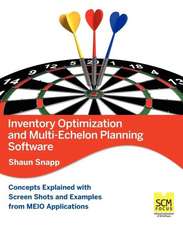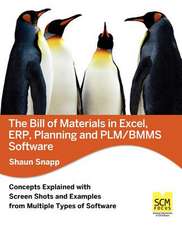Enterprise Networks and Telephony: From Technology to Business Strategy
Autor Solange Ghernaouti-Helie Traducere de I. Murrell Autor Arnaud Dufouren Limba Engleză Paperback – 19 ian 2012
Preț: 385.08 lei
Nou
Puncte Express: 578
Preț estimativ în valută:
73.69€ • 77.13$ • 61.33£
73.69€ • 77.13$ • 61.33£
Carte tipărită la comandă
Livrare economică 31 martie-14 aprilie
Preluare comenzi: 021 569.72.76
Specificații
ISBN-13: 9781447115663
ISBN-10: 144711566X
Pagini: 244
Ilustrații: XIII, 226 p.
Dimensiuni: 155 x 235 x 13 mm
Greutate: 0.35 kg
Ediția:Softcover reprint of the original 1st ed. 1998
Editura: SPRINGER LONDON
Colecția Springer
Locul publicării:London, United Kingdom
ISBN-10: 144711566X
Pagini: 244
Ilustrații: XIII, 226 p.
Dimensiuni: 155 x 235 x 13 mm
Greutate: 0.35 kg
Ediția:Softcover reprint of the original 1st ed. 1998
Editura: SPRINGER LONDON
Colecția Springer
Locul publicării:London, United Kingdom
Public țintă
Professional/practitionerCuprins
1 The Communicating Enterprise.- 1.1 Introduction.- 1.2 Networked Economy and Business Stakes.- 1.3 Networked Enterprise and Added Value.- 1.4 Networks Macrocosm.- 1.5 Conclusion.- 2 Enterprise Local Area Network Features and Operating Mode.- 2.1 Introduction.- 2.2 Notion of Service.- 2.3 Hardware Components.- 2.4 Software Components.- 2.5 Network Interconnection Issues.- 2.6 “Manware” components.- 2.7 Conclusion.- 3 Services and Applications.- 3.1 Introduction.- 3.2 File Management Services.- 3.3 Printing Services.- 3.4 Database Servers.- 3.5 Groupware and Office Automation.- 3.6 Electronic Mail.- 3.7 Internet Access.- 3.8 The Web.- 3.9 The Enterprise Intranet.- 3.10 Conclusion.- 4 Network Operating System.- 4.1 Stakes.- 4.2 The Particular Case of Peer to Peer Networking.- 4.3 Network Operating Systems Features.- 4.4 Additional Functions.- 4.5 Conclusion.- 5 Local Area Network Administration.- 5.1 Managing LANs in a Professional Way.- 5.2 The Network Administrator’s Key Roles.- 5.3 The Network Administrator’s Day-to-day Tasks.- 5.4 Conclusion.- 6 High-speed Local Area Networks.- 6.1 Evolution of Local Networks.- 6.2 Fibre-distributed Data Interface (FDDI).- 6.3 Fast Ethernet.- 6.4 Local Area Networks and ATM.- 6.5 Conclusion.- 7 Voice—Data—Image Telecommunications.- 7.1 Introduction.- 7.2 Telephony: Voice Telecommunications.- 7.3 Data Telecommunication.- 7.4 Voice—Data Hybrid Satellite Systems.- 7.5 Image Telecommunication.- 7.6 Support Networks.- 7.7 Conclusion.- 8 PBX.- 8.1 Introduction.- 8.2 PBX Features.- 8.3 The PBX: A Central Communication Node.- 8.4 CENTREX.- 8.5 Conclusion.- 9 Computer Telephony Integration (CTI).- 9.1 Introduction.- 9.2 From Utopia to Reality.- 9.3 Reasons for Integrating Computing and Telephony.- 9.4 Call Centres.- 9.5Applications and Services.- 9.6 Actors and Strategies.- 9.7 Conclusion.- 10 Mastering Telecommunications.- 10.1 Introduction.- 10.2 Strategic Planning.- 10.3 Telecommunications Planning.- 10.4 Modelling and Simulation.- 10.5 Quality Assurance.- 10.6 Conclusion.- 11 Network Management.- 11.1 Introduction.- 11.2 Network Management: The Strategic Viewpoint.- 11.3 Network Management: The Tactical Viewpoint.- 11.4 Network Management: The Operational Viewpoint.- 11.5 Outsourcing and Facilities Management.- 11.6 Normative Considerations.- 11.7 Conclusion.- 12 Network Security Management.- 12.1 Introduction.- 12.2 IT Risk Management.- 12.3 Security Policy.- 12.4 Threats to the Network.- 12.5 Conclusion.- 13 Network Audit.- 13.1 Introduction.- 13.2 Different Types of Audit.- 13.3 Computer Management Control.- 13.4 Computer Operations Management Internal Control.- 13.5 Information Systems Audit.- 13.6 Audit, Quality and ISO 9000 Certification.- 13.7 Conclusion.
Caracteristici
Telecommunications is an ever-expanding field of increasing importance for business Completely revised and updated version of the French publication Offers practical advice to IT professionals and students which will have immediate relevance

























